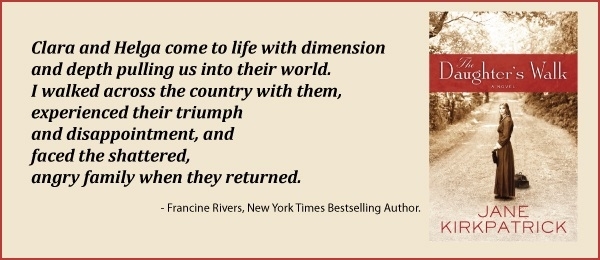A mother’s tragedy, a daughter’s desire and the 7000 mile journey that changed their lives.
In 1896 Norwegian American Helga Estby accepted a wager from the fashion industry to walk from Spokane, Washington to New York City within seven months in an effort to earn $10,000. Bringing along her nineteen year-old daughter Clara, the two made their way on the 3500-mile trek by following the railroad tracks and motivated by the money they needed to save the family farm. After returning home to the Estby farm more than a year later, Clara chose to walk on alone by leaving the family and changing her name. Her decisions initiated a more than 20-year separation from the only life she had known.
Historical fiction writer Jane Kirkpatrick picks up where the fact of the Estbys’ walk leaves off to explore Clara’s continued journey. What motivated Clara to take such a risk in an era when many women struggled with the issues of rights and independence? And what personal revelations brought Clara to the end of her lonely road? The Daughter’s Walk weaves personal history and fiction together to invite readers to consider their own journeys and family separations, to help determine what exile and forgiveness are truly about.
 The Daughter’s Walk: A Novel by Jane Kirkpatrick
The Daughter’s Walk: A Novel by Jane Kirkpatrick
My rating: 5 of 5 stars
I will admit that when I began this book, I wasn’t sure what I was going to think about it. I am a fan of historical fiction, and it was neat that it was taking place in my home state–Washington. It was a slow beginning, but the story of these remarkable women and their journey intrigued me.
By the time I got to the second section of the book (it is divided into three parts), I fully realized this was a true story. Why, you might ask? Because sad things were happening that I did not want to have happen to the heroine. I wanted everything to work out well for her, but (not a spoiler, I promise!) things did not always work out the way I thought they should. Even the epilogue kept me guessing!
There were a lot of issues the author discussed in the book that Christian historical fiction authors do not usually discuss–homosexuality, female pastors, courtesans amongst other things. I remember that as I read certain portions of the story that these issues crossed my mind, but I was totally shocked when the author handled each of these issues with great delicacy.
Telling this story in first person from our heroine’s point of view was quite a smart tactic where this book was concerned. I think that since the reader only got into Clara’s head, it provides for more suspense.
I also enjoyed the fact that faith is strong but not overdone in this book. I cannot tell you how much I appreciate books that do not force the Christian message. It makes much more sense when faith flows freely from the characters, and it does in this book.
And finally, I was enthralled with the section the author wrote at the end of the novel. I was impressed with all the work she did in research for this book–she worked very hard to write this book, and it certainly does come across in the book. While the book is not 100 percent true, more of what she wrote it true than not. I cannot recommend this book highly enough!
About the Author:
 Jane is internationally recognized for her lively presentations and well-researched stories that encourage and inspire. Her works have appeared in more than 50 publications including Decision, Private Pilot and Daily Guideposts. Jane is the author of 20 books including 17 historical novels. Many of her titles are based on the lives of real people or incidents set authentically in the American West. Her first novel, A Sweetness to the Soul, won the coveted Wrangler Award from the Western Heritage Center. Her works have been finalists for the Christy, Spur, Oregon Book Award, WILLA Literary Award and Reader’s Choice awards. Several of her titles have been Book of the Month and Literary Guild selections.
Jane is internationally recognized for her lively presentations and well-researched stories that encourage and inspire. Her works have appeared in more than 50 publications including Decision, Private Pilot and Daily Guideposts. Jane is the author of 20 books including 17 historical novels. Many of her titles are based on the lives of real people or incidents set authentically in the American West. Her first novel, A Sweetness to the Soul, won the coveted Wrangler Award from the Western Heritage Center. Her works have been finalists for the Christy, Spur, Oregon Book Award, WILLA Literary Award and Reader’s Choice awards. Several of her titles have been Book of the Month and Literary Guild selections.
“I received this book for free from WaterBrook Multnomah Publishing Group for this review”.
FOLLOW JANE
1 Comment
-
I appreciate the way you covered this book without giving away the story and I’m honored to have your five star review! Warmly, Jane



